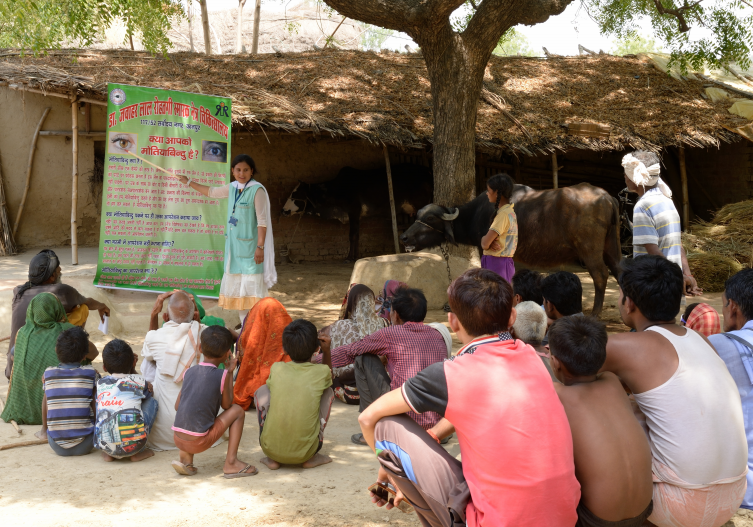One of the most significant ways in which Operation Eyesight eliminates avoidable blindness is through our Hospital-Based Community Eye Health Program, which is a real mouthful. And it doesn’t stop with the title. The model is complex, and has many moving parts, so that’s why we’re thrilled to have a full breakdown of the program model and how it works to share with you.
Our Global Director of Programs, Kashinath Bhoosnurmath, is an expert in eye health development. He knows how important eye health care is in the communities where we work. That’s why he and our team developed our model of sustainable eye health care, to address the many barriers facing these communities and give them access to the care they need.
Kashinath recently wrote an article for the prestigious Community Eye Health Journal about our Hospital-Based Community Eye Health Program (HBCEHP). In it, he discusses the importance of reaching people who would otherwise go unreached. Despite improvements in some of the countries we work in (better infrastructure and a growing middle class), there are still millions of people suffering from avoidable blindness.
There are many barriers to obtaining eye care in the countries where we work. Economic barriers are common for the people we help; many of them cannot afford the cost of treatment for their eye care. Also,local hospitals desperately need trained eye health care professionals and equipment to provide professional eye health care services.

Not only this, but there are other barriers you might not expect when it comes to providing communities in need with eye health care. That’s why our HBCEHP model takes into account the problems these communities face, as shown in the following excerpt from Kash’s article.
“Hospital-Based Community Eye Health Programme (HBCEHP): The model
Poor eye health-seeking behaviour usually stems from inadequate knowledge of eye diseases, harmful cultural beliefs and practices, eye problems viewed as low priority, gender discrimination, lack of affordability and poor mobility amongst the elderly. Often hospitals:
- Provide eye care services but do not empower targeted communities;
- Do not focus on the elimination of avoidable blindness; and
- Make services available free of cost, but poor patients at risk of losing their sight do not access these services.
[…] The above analyses led us to the conclusion that there were gaps in the services offered by hospitals and that greater effort was needed to empower the target communities.
Through a pilot project implemented from 2009 to 2013 in southern India, we learned that by empowering people living in the service area of the hospital and improving their eye health-seeking behaviour, while continuing to deliver quality eye care services, hospitals could significantly contribute to the elimination of avoidable blindness on a sustainable basis. This insight led us to develop and successfully scale up a model, named Hospital-Based Community Eye Health Programme (HBCEHP).”
By discovering the issues that affected communities suffering with avoidable blindness, our team built the model to include the “strengthening [of] hospitals to ensure delivery of quality services; strengthening primary health services, including primary eye care services; and empowering target communities to take ownership and responsibility for their eye health needs.”
Empowering communities to seek out professional eye health care is especially important, and that’s where community health workers come in. They are usually women who are selected from the very communities we aim to help, then they’re trained to go door-to-door to screen people for eye health issues, and to refer them for treatment or further diagnosis if necessary.
And the best part of our model is that it’s self-sustaining. By helping build capacity in the hospitals we partner with, we make it possible for them to attract patients who can afford their treatment, and these paying patients in turn help subsidize the treatment of those living in poor communities who could not afford the eye health care they need.
Even this is just an overview. If you want to learn more about the model, you can read Kashinath’s full article here.
Implementing our model is made possible by the generosity of supporters like you! There are already hundreds of communities being helped, but there are still hundreds more that do not have access to quality eye health care. Please consider becoming a monthly donor to help us reach more communities in need – For All the World to See!

